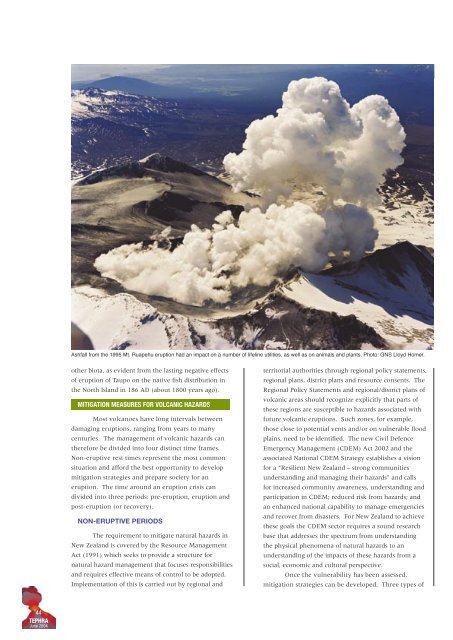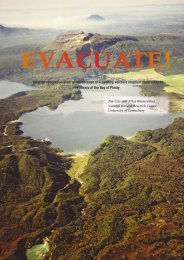Volcanoes - Ministry of Civil Defence and Emergency Management
Volcanoes - Ministry of Civil Defence and Emergency Management
Volcanoes - Ministry of Civil Defence and Emergency Management
You also want an ePaper? Increase the reach of your titles
YUMPU automatically turns print PDFs into web optimized ePapers that Google loves.
Ashfall from the 1995 Mt. Ruapehu eruption had an impact on a number <strong>of</strong> lifeline utilities, as well as on animals <strong>and</strong> plants. Photo: GNS Lloyd Homer.<br />
other biota, as evident from the lasting negative effects<br />
<strong>of</strong> eruption <strong>of</strong> Taupo on the native fish distribution in<br />
the North Isl<strong>and</strong> in 186 AD (about 1800 years ago).<br />
MITIGATION MEASURES FOR VOLCANIC HAZARDS<br />
Most volcanoes have long intervals between<br />
damaging eruptions, ranging from years to many<br />
centuries. The management <strong>of</strong> volcanic hazards can<br />
therefore be divided into four distinct time frames.<br />
Non-eruptive rest times represent the most common<br />
situation <strong>and</strong> afford the best opportunity to develop<br />
mitigation strategies <strong>and</strong> prepare society for an<br />
eruption. The time around an eruption crisis can<br />
divided into three periods: pre-eruption, eruption <strong>and</strong><br />
post-eruption (or recovery).<br />
NON-ERUPTIVE PERIODS<br />
The requirement to mitigate natural hazards in<br />
New Zeal<strong>and</strong> is covered by the Resource <strong>Management</strong><br />
Act (1991) which seeks to provide a structure for<br />
natural hazard management that focuses responsibilities<br />
<strong>and</strong> requires effective means <strong>of</strong> control to be adopted.<br />
Implementation <strong>of</strong> this is carried out by regional <strong>and</strong><br />
territorial authorities through regional policy statements,<br />
regional plans, district plans <strong>and</strong> resource consents. The<br />
Regional Policy Statements <strong>and</strong> regional/district plans <strong>of</strong><br />
volcanic areas should recognize explicitly that parts <strong>of</strong><br />
these regions are susceptible to hazards associated with<br />
future volcanic eruptions. Such zones, for example,<br />
those close to potential vents <strong>and</strong>/or on vulnerable flood<br />
plains, need to be identified. The new <strong>Civil</strong> <strong>Defence</strong><br />
<strong>Emergency</strong> <strong>Management</strong> (CDEM) Act 2002 <strong>and</strong> the<br />
associated National CDEM Strategy establishes a vision<br />
for a “Resilient New Zeal<strong>and</strong> – strong communities<br />
underst<strong>and</strong>ing <strong>and</strong> managing their hazards” <strong>and</strong> calls<br />
for increased community awareness, underst<strong>and</strong>ing <strong>and</strong><br />
participation in CDEM; reduced risk from hazards; <strong>and</strong><br />
an enhanced national capability to manage emergencies<br />
<strong>and</strong> recover from disasters. For New Zeal<strong>and</strong> to achieve<br />
these goals the CDEM sector requires a sound research<br />
base that addresses the spectrum from underst<strong>and</strong>ing<br />
the physical phenomena <strong>of</strong> natural hazards to an<br />
underst<strong>and</strong>ing <strong>of</strong> the impacts <strong>of</strong> these hazards from a<br />
social, economic <strong>and</strong> cultural perspective.<br />
Once the vulnerability has been assessed,<br />
mitigation strategies can be developed. Three types <strong>of</strong><br />
44<br />
TEPHRA<br />
June 2004

















